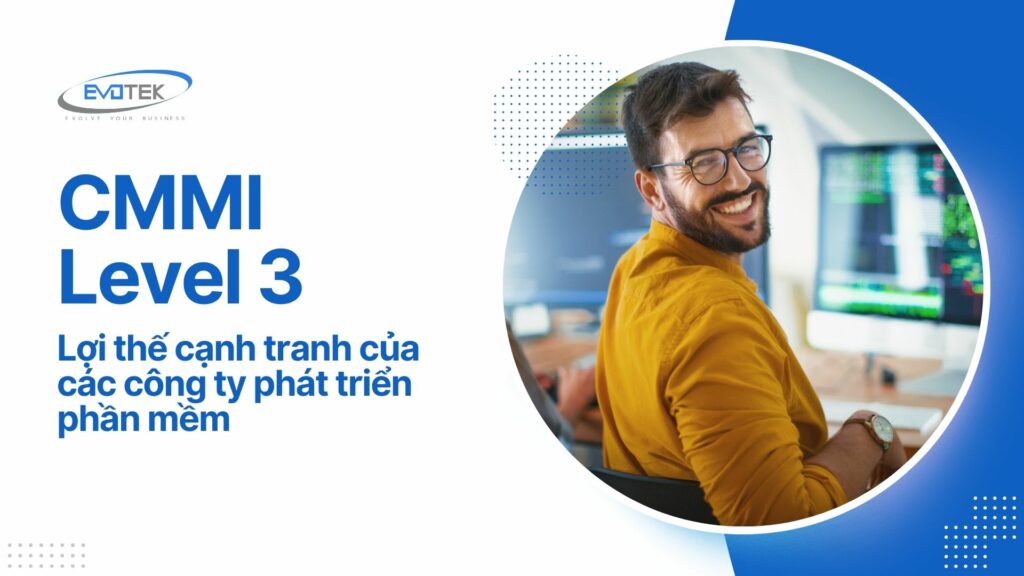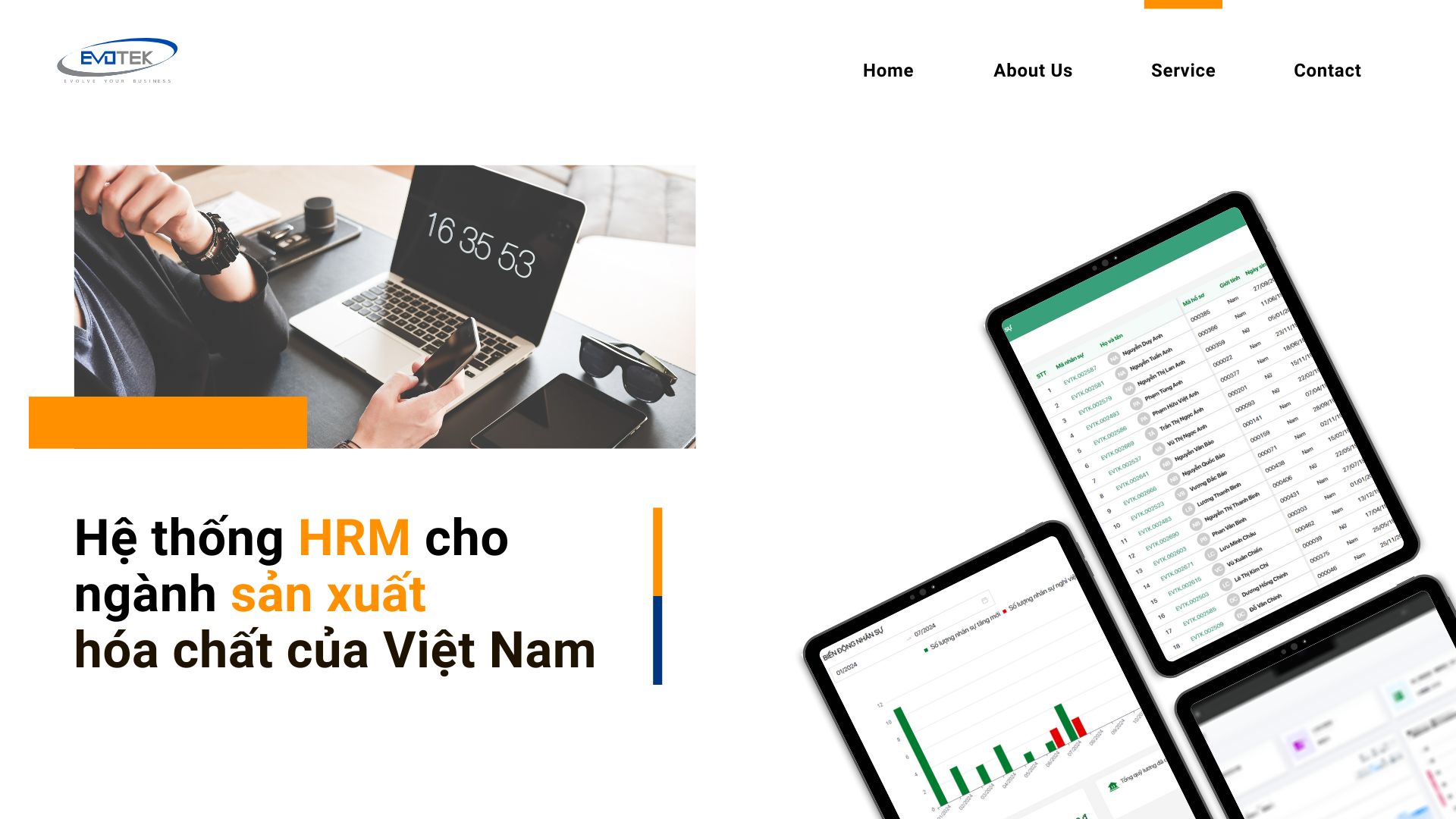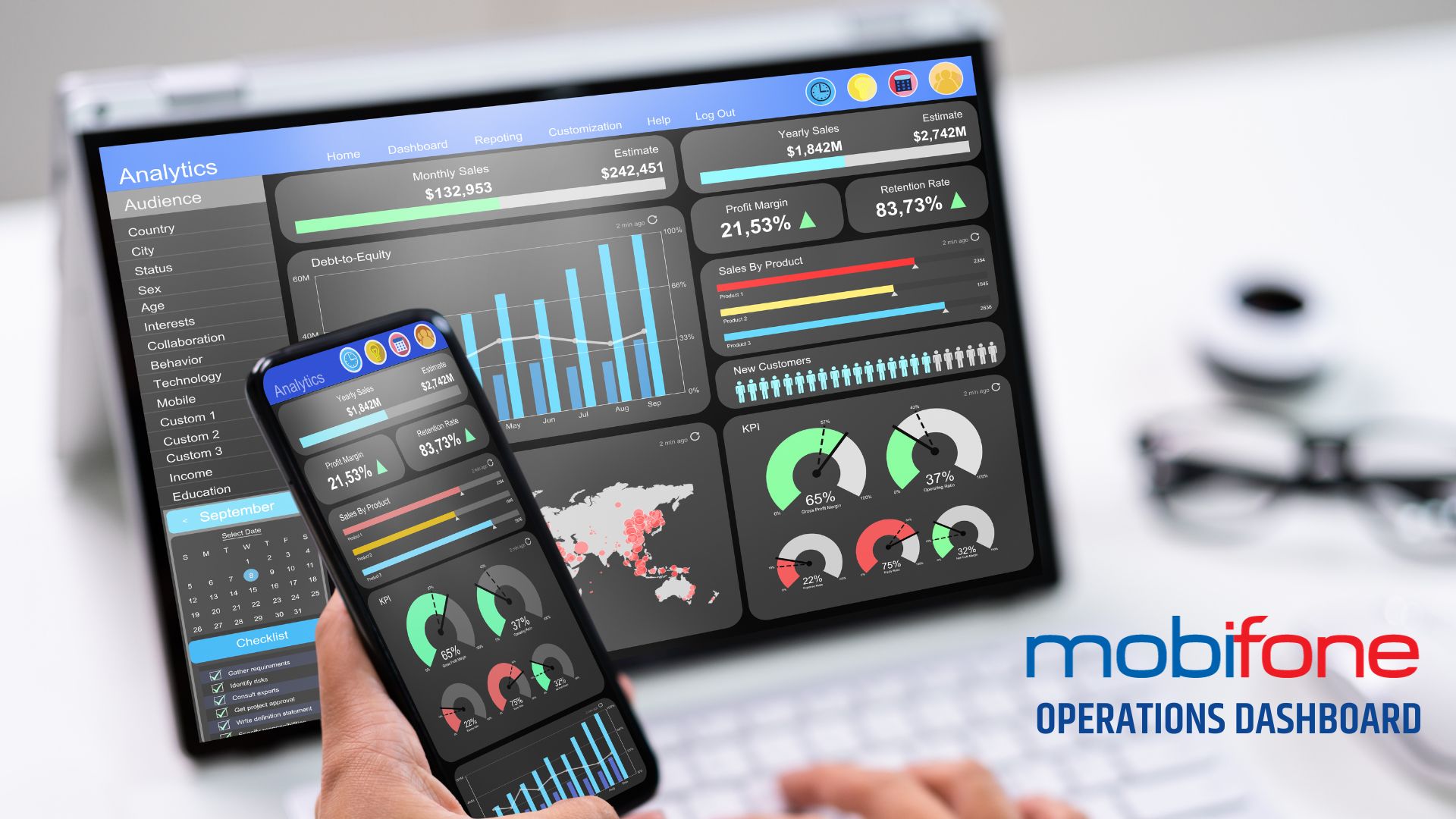Nhu cầu sử dụng công nghệ thông tin tăng mạnh thúc đẩy các doanh nghiệp tìm kiếm đối tác cung cấp dịch vụ CNTT đáng tin cậy, chất lượng cao. Trong bối cảnh đó, chứng chỉ CMMI Level 3 đã trở thành một chỉ số quan trọng để đánh giá mức độ uy tín và năng lực của các công ty phần mềm, đặc biệt là khả năng triển khai các dự án phần mềm lớn nhờ quy trình làm việc chuyên nghiệp.
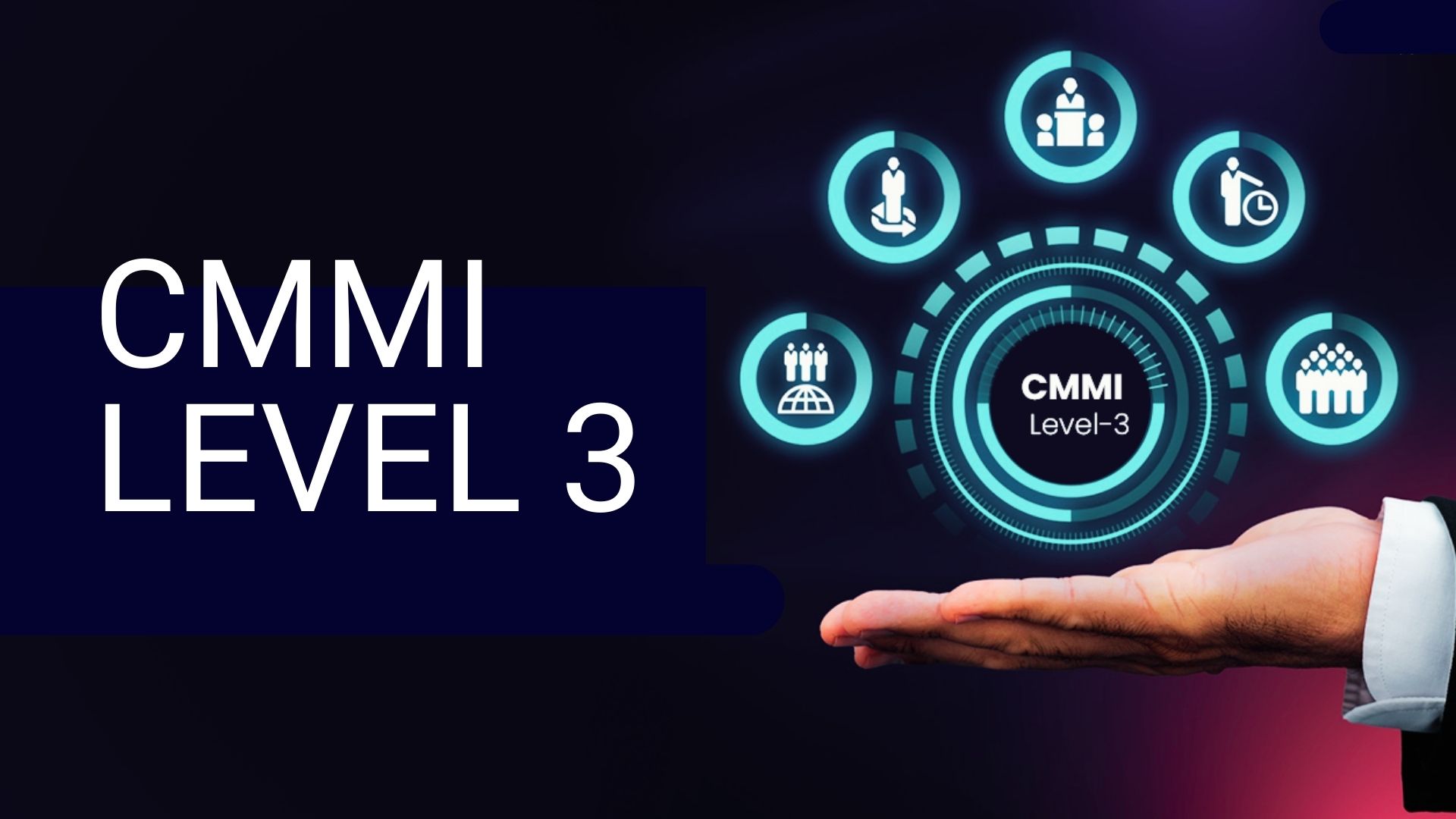
Vậy CMMI Level 3 là gì và tại sao các doanh nghiệp nên lựa chọn đối tác có chứng chỉ này? Bài viết sau đây của Evotek sẽ lý giải chi tiết về vấn đề này.
1. Giới thiệu về CMMI
CMMI (Capability Maturity Model Integration) là một mô hình trưởng thành năng lực, được phát triển bởi Viện Kỹ thuật Phần mềm Hoa Kỳ (SEI).
CMMI cung cấp các hướng dẫn và tiêu chí để đánh giá khả năng, quy trình quản lý chất lượng của các tổ chức phát triển phần mềm. Thông qua CMMI, các công ty có thể nâng cao năng lực quản lý, tối ưu hóa quy trình và cải tiến về chất lượng sản phẩm.
CMMI chia thành 5 mức độ trưởng thành khác nhau, bao gồm:
- CMMI Level 1 – Bước đầu
- CMMI Level 2 – Quy trình được quản lý
- CMMI Level 3 – Quy trình được xác định
- CMMI Level 4 – Quy trình được quản lý định lượng
- CMMI Level 5 – Quy trình được tối ưu
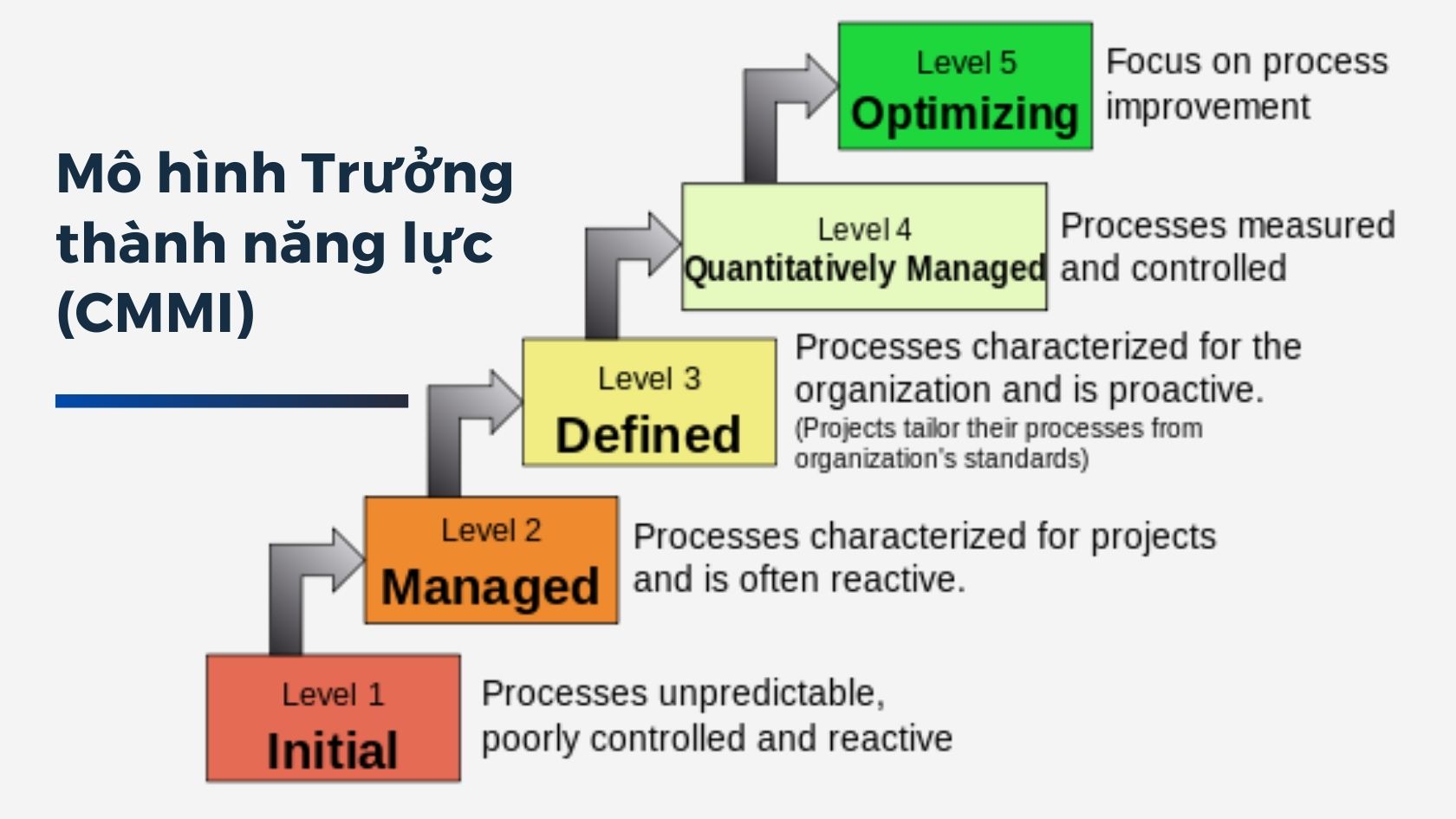
Mỗi mức đều thể hiện trình độ và năng lực khác nhau của doanh nghiệp phần mềm. Do đó, CMMI giúp khách hàng đánh giá và lựa chọn đối tác cung cấp dịch vụ.
2. CMMI Level 3 là gì?
CMMI Level 3, hay còn gọi là “Quy trình được xác định”, thể hiện công ty phần mềm đã có hệ thống quy trình chuẩn mực và phù hợp.
Ở mức này, công ty xây dựng quy trình chuẩn cho từng giai đoạn trong vòng đời phát triển phần mềm (SDLC). Các quy trình chuẩn này được áp dụng cho tất cả dự án thông qua quản lý dự án hiệu quả.
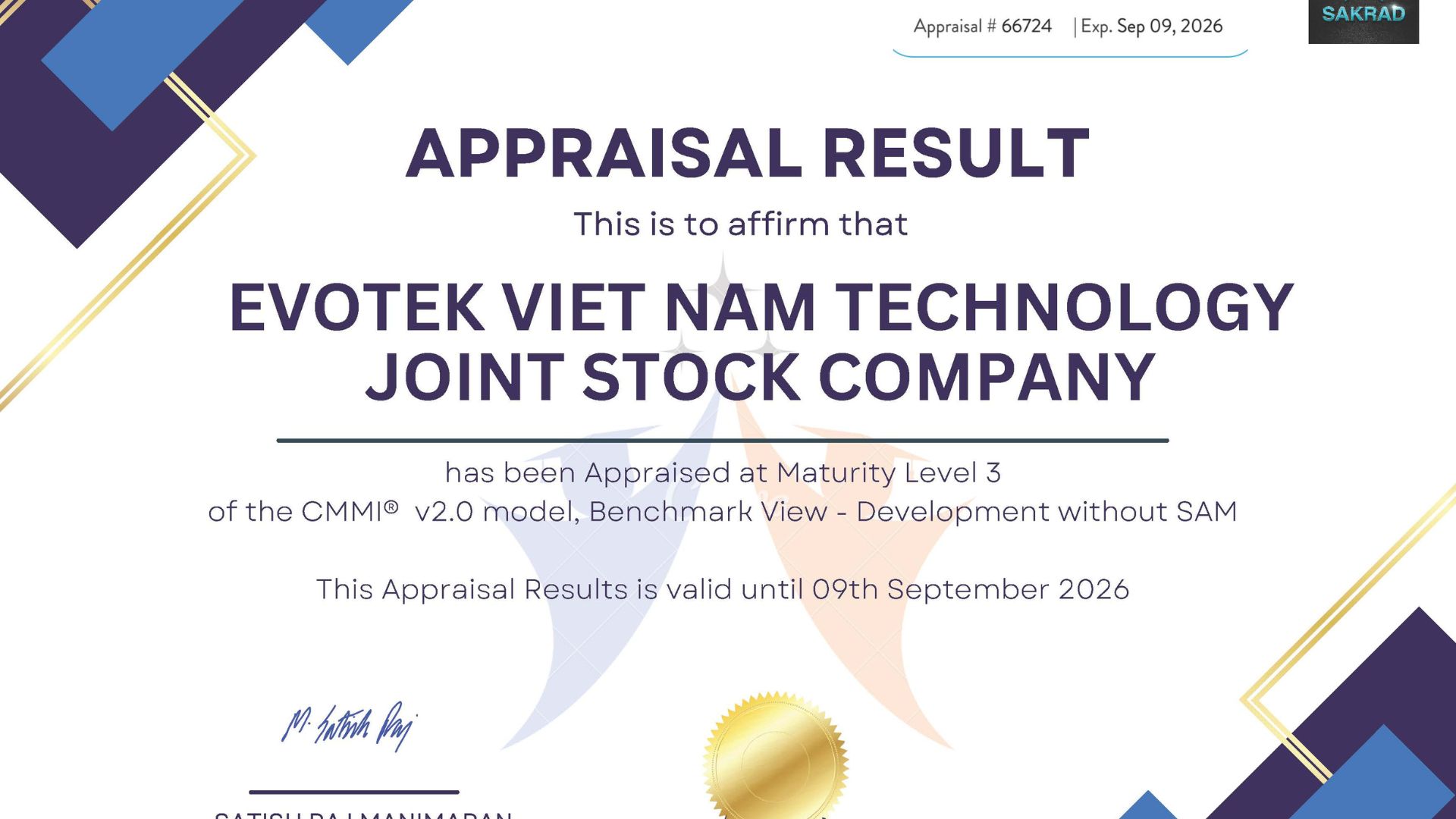
Điểm mạnh của CMMI Level 3:
- Quy trình chuẩn rõ ràng cho mọi dự án
- Chất lượng và hiệu quả công việc tối ưu hơn
- Rủi ro về chi phí, tiến độ, chất lượng giảm thiểu
- Đảm bảo khách hàng hài lòng hơn về sản phẩm
Do đó, sở hữu chứng nhận CMMI mức 3 phản ánh công ty phần mềm có năng lực quản lý dự án hiệu quả, đáp ứng tốt nhu cầu khách hàng.
Những tiêu chí để đạt được CMMI Theo từng level (Lưu ý: Bảng rất dài)
| 2 – Managed | Requirements Management | Manage Requirements | Obtain an Understanding of Requirements | 1 | 2 | 4 | 8 | 16 | 32 | 100% |
| Obtain Commitment to Requirements | 1 | 2 | 4 | 8 | 16 | 32 | 100% | |||
| Manage Requirements Changes | 1 | 2 | 4 | 8 | 16 | 32 | 100% | |||
| Maintain Bidirectional Traceability of Requirements | 1 | 2 | 4 | 8 | 16 | 32 | 100% | |||
| Identify Inconsistencies Between Project Work and Requirements | 1 | 2 | 4 | 8 | 16 | 32 | 100% | |||
| Project Planning | Establish Estimates | Estimate the Scope of the Project | 1 | 2 | 4 | 8 | 16 | 32 | 100% | |
| Establish Estimates of Work Product and Task Attributes | 1 | 2 | 4 | 8 | 16 | 32 | 100% | |||
| Define Project Life Cycle | 1 | 2 | 4 | 8 | 16 | 32 | 100% | |||
| Determine Estimates of Effort and Cost | 1 | 2 | 4 | 8 | 16 | 32 | 100% | |||
| Develop a Project Plan | Establish the Budget and Schedule | 1 | 2 | 4 | 8 | 16 | 32 | 100% | ||
| Identify Project Risks | 1 | 2 | 4 | 8 | 16 | 32 | 100% | |||
| Plan for Data Management | 1 | 2 | 4 | 8 | 16 | 32 | 100% | |||
| Plan for Project Resources | 1 | 2 | 4 | 8 | 16 | 32 | 100% | |||
| Plan for Needed Knowledge and Skills | 1 | 2 | 4 | 8 | 16 | 32 | 100% | |||
| Plan Stakeholder Involvement | 1 | 2 | 4 | 8 | 16 | 32 | 100% | |||
| Establish the Project Plan | 1 | 2 | 4 | 8 | 16 | 32 | 100% | |||
| Obtain Commitment to the Plan | Review Plans that Affect the Project | 1 | 2 | 4 | 8 | 16 | 32 | 100% | ||
| Reconcile Work and Resource Levels | 1 | 2 | 4 | 8 | 16 | 32 | 100% | |||
| Obtain Plan Commitment | 1 | 2 | 4 | 8 | 16 | 32 | 100% | |||
| Project Monitoring and Control | Monitor Project Against Plan | Monitor Project Planning Parameters | 1 | 2 | 4 | 8 | 16 | 32 | 100% | |
| Monitor Commitments | 1 | 2 | 4 | 8 | 16 | 32 | 100% | |||
| Monitor Project Risks | 1 | 2 | 4 | 8 | 16 | 32 | 100% | |||
| Monitor Data Management | 1 | 2 | 4 | 8 | 16 | 32 | 100% | |||
| Monitor Stakeholder Involvement | 1 | 2 | 4 | 8 | 16 | 32 | 100% | |||
| Conduct Progress Reviews | 1 | 2 | 4 | 8 | 16 | 32 | 100% | |||
| Conduct Milestone Reviews | 1 | 2 | 4 | 8 | 16 | 32 | 100% | |||
| Manage Corrective Action to Closure | Analyze Issues | 1 | 2 | 4 | 8 | 16 | 32 | 100% | ||
| Take Correction Action | 1 | 2 | 4 | 8 | 16 | 32 | 100% | |||
| Manage Corrective Action | 1 | 2 | 4 | 8 | 16 | 32 | 100% | |||
| Supplier Agreement Management | Establish Supplier Agreements | Determine Acquisition Type | 1 | 2 | 4 | 8 | 16 | 32 | 100% | |
| Select Suppliers | 1 | 2 | 4 | 8 | 16 | 32 | 100% | |||
| Establish Supplier Agreements | 1 | 2 | 4 | 8 | 16 | 32 | 100% | |||
| Satisfy Supplier Agreements | Review COTS Products | 1 | 2 | 4 | 8 | 16 | 32 | 100% | ||
| Execute the Supplier Agreement | 1 | 2 | 4 | 8 | 16 | 32 | 100% | |||
| Accept the Acquired Product | 1 | 2 | 4 | 8 | 16 | 32 | 100% | |||
| Transition Products | 1 | 2 | 4 | 8 | 16 | 32 | 100% | |||
| Measurement and Analysis | Align Measurement and Analysis Activities | Establish Measurement Objectives | 1 | 2 | 4 | 8 | 16 | 32 | 100% | |
| Specify Measures | 1 | 2 | 4 | 8 | 16 | 32 | 100% | |||
| Specify Data Collection and Storage Procedures | 1 | 2 | 4 | 8 | 16 | 32 | 100% | |||
| Specify Analysis Procedures | 1 | 2 | 4 | 8 | 16 | 32 | 100% | |||
| Provide Measurement Results | Collect Measurement Data | 1 | 2 | 4 | 8 | 16 | 32 | 100% | ||
| Analyze Measurement Data | 1 | 2 | 4 | 8 | 16 | 32 | 100% | |||
| Store Data and Results | 1 | 2 | 4 | 8 | 16 | 32 | 100% | |||
| Communicate Results | 1 | 2 | 4 | 8 | 16 | 32 | 100% | |||
| Process and Product Quality Assurance | Objectively Evaluate Processes | Objectively Evaluate Processes | 1 | 2 | 4 | 8 | 16 | 32 | 100% | |
| Objectively Evaluate Work Products and Services | 1 | 2 | 4 | 8 | 16 | 32 | 100% | |||
| Provide Objective Insight | Communicate and Ensure Resolution of Noncompliance Issues | 1 | 2 | 4 | 8 | 16 | 32 | 100% | ||
| Establish Records | 1 | 2 | 4 | 8 | 16 | 32 | 100% | |||
| Configuration Management | Establish Baselines | Identify Configuration Items | 1 | 2 | 4 | 8 | 16 | 32 | 100% | |
| Establish a Configuration Management System | 1 | 2 | 4 | 8 | 16 | 32 | 100% | |||
| Create or Release Baselines | 1 | 2 | 4 | 8 | 16 | 32 | 100% | |||
| Track and Control Changes | Track Change Requests | 1 | 2 | 4 | 8 | 16 | 32 | 100% | ||
| Control Configuration Items | 1 | 2 | 4 | 8 | 16 | 32 | 100% | |||
| Establish Integrity | Establish Configuration Management Records | 1 | 2 | 4 | 8 | 16 | 32 | 100% | ||
| Perform Configuration Audits | 1 | 2 | 4 | 8 | 16 | 32 | 100% | |||
| CMMI Level 2 Score | 100% | 100% | 100% | 100% | 100% | 100% | 100% | |||
| 3 – Defined | Requirements Development | Develop Customer Requirements | Collect Stakeholder Needs | 1 | 2 | 4 | 8 | 16 | 32 | 100% |
| Elicit Needs | 1 | 2 | 4 | 8 | 16 | 32 | 100% | |||
| Develop the Customer Requirements | 1 | 2 | 4 | 8 | 16 | 32 | 100% | |||
| Develop Product Requirements | Establish Product and Product-Component Requirements | 1 | 2 | 4 | 8 | 16 | 32 | 100% | ||
| Allocate Product Component Requirements | 1 | 2 | 4 | 8 | 16 | 32 | 100% | |||
| Identify Interface Requirements | 1 | 2 | 4 | 8 | 16 | 32 | 100% | |||
| Analyze and Validate Requirements | Establish Operational Concepts and Scenarios | 1 | 2 | 4 | 8 | 16 | 32 | 100% | ||
| Establish a Definition of Required Functionality | 1 | 2 | 4 | 8 | 16 | 32 | 100% | |||
| Analyze Requirements | 1 | 2 | 4 | 8 | 16 | 32 | 100% | |||
| Analyze Requirements to Achieve Balance | 1 | 2 | 4 | 8 | 16 | 32 | 100% | |||
| Validate Requirements | 1 | 2 | 4 | 8 | 16 | 32 | 100% | |||
| Validate Requirements with Comprehensive Methods | 1 | 2 | 4 | 8 | 16 | 32 | 100% | |||
| Technical Solution | Select Product- Component Solutions | Develop Alternative Solutions and Selection Criteria | 1 | 2 | 4 | 8 | 16 | 32 | 100% | |
| Develop Detailed Alternative Solutions and Selection Criteria | 1 | 2 | 4 | 8 | 16 | 32 | 100% | |||
| Evolve Operational Concepts and Scenarios | 1 | 2 | 4 | 8 | 16 | 32 | 100% | |||
| Select Product-Component Solutions | 1 | 2 | 4 | 8 | 16 | 32 | 100% | |||
| Develop the Design | Design the Product or Product Component | 1 | 2 | 4 | 8 | 16 | 32 | 100% | ||
| Establish a Technical Data Package | 1 | 2 | 4 | 8 | 16 | 32 | 100% | |||
| Establish Interface Descriptions | 1 | 2 | 4 | 8 | 16 | 32 | 100% | |||
| Design Interfaces Using Criteria | 1 | 2 | 4 | 8 | 16 | 32 | 100% | |||
| Perform Make, Buy, or Reuse Analyses | 1 | 2 | 4 | 8 | 16 | 32 | 100% | |||
| Implement the Product Design | Implement the Design | 1 | 2 | 4 | 8 | 16 | 32 | 100% | ||
| Develop Product Support Documentation | 1 | 2 | 4 | 8 | 16 | 32 | 100% | |||
| Product Integration | Prepare for Product Integration | Determine Integration Sequence | 1 | 2 | 4 | 8 | 16 | 32 | 100% | |
| Establish the Product Integration Environment | 1 | 2 | 4 | 8 | 16 | 32 | 100% | |||
| Establish Product Integration Procedures and Criteria | 1 | 2 | 4 | 8 | 16 | 32 | 100% | |||
| Ensure Interface Compatibility | Review Interface Descriptions for Completeness | 1 | 2 | 4 | 8 | 16 | 32 | 100% | ||
| Manage Interfaces | 1 | 2 | 4 | 8 | 16 | 32 | 100% | |||
| Assemble Product Components and Deliver the Product | Confirm Readiness of Product Components for Integration | 1 | 2 | 4 | 8 | 16 | 32 | 100% | ||
| Assemble Product Components | 1 | 2 | 4 | 8 | 16 | 32 | 100% | |||
| Evaluate Assembled Product Components | 1 | 2 | 4 | 8 | 16 | 32 | 100% | |||
| Package and Deliver the Product or Product Component | 1 | 2 | 4 | 8 | 16 | 32 | 100% | |||
| Verification | Prepare for Verification | Select Work Products for Verification | 1 | 2 | 4 | 8 | 16 | 32 | 100% | |
| Establish the Verification Environment | 1 | 2 | 4 | 8 | 16 | 32 | 100% | |||
| Establish Verification Procedures and Criteria | 1 | 2 | 4 | 8 | 16 | 32 | 100% | |||
| Perform Peer Reviews | Prepare for Peer Reviews | 1 | 2 | 4 | 8 | 16 | 32 | 100% | ||
| Conduct Peer Reviews | 1 | 2 | 4 | 8 | 16 | 32 | 100% | |||
| Analyze Peer Review Data | 1 | 2 | 4 | 8 | 16 | 32 | 100% | |||
| Verify Selected Work Products | Perform Verification | 1 | 2 | 4 | 8 | 16 | 32 | 100% | ||
| Analyze Verification Results and Identify Corrective Action | 1 | 2 | 4 | 8 | 16 | 32 | 100% | |||
| Prepare for Validatio | Select Products for Validation | 1 | 2 | 4 | 8 | 16 | 32 | 100% | ||
| Establish the Validation Environment | 1 | 2 | 4 | 8 | 16 | 32 | 100% | |||
| Validation | Establish Validation Procedures and Criteria | 1 | 2 | 4 | 8 | 16 | 32 | 100% | ||
| Validate Product or Product | Perform Validation | 1 | 2 | 4 | 8 | 16 | 32 | 100% | ||
| Analyze Validation Results | 1 | 2 | 4 | 8 | 16 | 32 | 100% | |||
| Organizational Process Focus | Determine Process- Improvement Opportunities | Establish Organizational Process Needs | 1 | 2 | 4 | 8 | 16 | 32 | 100% | |
| Appraise the Organization’s Processes | 1 | 2 | 4 | 8 | 16 | 32 | 100% | |||
| Identify the Organization’s Process Improvements | 1 | 2 | 4 | 8 | 16 | 32 | 100% | |||
| Plan and Implement Process- Improvement Activities | Establish Process Action Plans | 1 | 2 | 4 | 8 | 16 | 32 | 100% | ||
| Implement Process Action Plans | 1 | 2 | 4 | 8 | 16 | 32 | 100% | |||
| Deploy Organizational Process Assets | 1 | 2 | 4 | 8 | 16 | 32 | 100% | |||
| Incorporate Process-Related Experiences into the Organizational Proce | 1 | 2 | 4 | 8 | 16 | 32 | 100% | |||
| Organizational Process Definition | Establish Organizational Process Assets | Establish Standard Processes | 1 | 2 | 4 | 8 | 16 | 32 | 100% | |
| Establish Life-Cycle Model Descriptions | 1 | 2 | 4 | 8 | 16 | 32 | 100% | |||
| Establish Tailoring Criteria and Guidelines | 1 | 2 | 4 | 8 | 16 | 32 | 100% | |||
| Establish the Organization’s Measurement Repository | 1 | 2 | 4 | 8 | 16 | 32 | 100% | |||
| Establish the Organization’s Process Asset Library | 1 | 2 | 4 | 8 | 16 | 32 | 100% | |||
| Organizational Training | Establish an Organizational Training Capability | Establish the Strategic Training Needs | 1 | 2 | 4 | 8 | 16 | 32 | 100% | |
| Determine Which Training Needs Are the Responsibility of Organizati | 1 | 2 | 4 | 8 | 16 | 32 | 100% | |||
| Establish an Organizational Training Tactical Plan | 1 | 2 | 4 | 8 | 16 | 32 | 100% | |||
| Establish Training Capability | 1 | 2 | 4 | 8 | 16 | 32 | 100% | |||
| Provide Necessary Training | Deliver Training | 1 | 2 | 4 | 8 | 16 | 32 | 100% | ||
| Establish Training Records | 1 | 2 | 4 | 8 | 16 | 32 | 100% | |||
| Assess Training Effectiveness | 1 | 2 | 4 | 8 | 16 | 32 | 100% | |||
| Integrated Project Management for IPPD | Use the Project’s Defined Process | Establish the Project’s Defined Process | 1 | 2 | 4 | 8 | 16 | 32 | 100% | |
| Use Organizational Process Assets for Planning Project Activities | 1 | 2 | 4 | 8 | 16 | 32 | 100% | |||
| Integrate Plans | 1 | 2 | 4 | 8 | 16 | 32 | 100% | |||
| Manage the Project Using the Integrated Plans | 1 | 2 | 4 | 8 | 16 | 32 | 100% | |||
| Contribute to the Organizational Process Assets | 1 | 2 | 4 | 8 | 16 | 32 | 100% | |||
| Coordinate and Collaborate with Relevant | Manage Stakeholder Involvement | 1 | 2 | 4 | 8 | 16 | 32 | 100% | ||
| Manage Dependencies | 1 | 2 | 4 | 8 | 16 | 32 | 100% | |||
| Resolve Coordination Issues | 1 | 2 | 4 | 8 | 16 | 32 | 100% | |||
| Use the Project’s Shared Vision for | Define Project’s Shared-Vision Context | 1 | 2 | 4 | 8 | 16 | 32 | 100% | ||
| Establish the Project’s Shared Vision | 1 | 2 | 4 | 8 | 16 | 32 | 100% | |||
| Organize Integrated Teams for IPPD | Determine Integrated Team Structure for the Project | 1 | 2 | 4 | 8 | 16 | 32 | 100% | ||
| Develop Preliminary Distribution of Requirements to Integrated Teams | 1 | 2 | 4 | 8 | 16 | 32 | 100% | |||
| Establish Integrated Teams | 1 | 2 | 4 | 8 | 16 | 32 | 100% | |||
| Risk Management | Prepare for Risk Management | Determine Risk Sources and Categories | 1 | 2 | 4 | 8 | 16 | 32 | 100% | |
| Define Risk Parameters | 1 | 2 | 4 | 8 | 16 | 32 | 100% | |||
| Establish a Risk Management Strategy | 1 | 2 | 4 | 8 | 16 | 32 | 100% | |||
| Identify and Analyze Risks | Identify Risks | 1 | 2 | 4 | 8 | 16 | 32 | 100% | ||
| Evaluate, Categorize, and Prioritize Risks | 1 | 2 | 4 | 8 | 16 | 32 | 100% | |||
| Mitigate Risks | Develop Risk Mitigation Plans | 1 | 2 | 4 | 8 | 16 | 32 | 100% | ||
| Implement Risk Mitigation Plans | 1 | 2 | 4 | 8 | 16 | 32 | 100% | |||
| Integrated Teaming | Establish Team Composition | Identify Team Tasks | 1 | 2 | 4 | 8 | 16 | 32 | 100% | |
| Identify Needed Knowledge and Skills | 1 | 2 | 4 | 8 | 16 | 32 | 100% | |||
| Assign Appropriate Team Members | 1 | 2 | 4 | 8 | 16 | 32 | 100% | |||
| Govern Team Operation | Establish a Shared Vision | 1 | 2 | 4 | 8 | 16 | 32 | 100% | ||
| Establish a Team Charter | 1 | 2 | 4 | 8 | 16 | 32 | 100% | |||
| Define Roles and Responsibilities | 1 | 2 | 4 | 8 | 16 | 32 | 100% | |||
| Establish Operating Procedures | 1 | 2 | 4 | 8 | 16 | 32 | 100% | |||
| Collaborate Among Interfacing Teams | 1 | 2 | 4 | 8 | 16 | 32 | 100% | |||
| Integrated Supplier Management | Analyze and Select Sources of Products | Analyze Potential Sources of Products | 1 | 2 | 4 | 8 | 16 | 32 | 100% | |
| Evaluate and Determine Sources of Products | 1 | 2 | 4 | 8 | 16 | 32 | 100% | |||
| Coordinate Work with Suppliers | Monitor Selected Supplier Work Products | 1 | 2 | 4 | 8 | 16 | 32 | 100% | ||
| Evaluate Selected Supplier Work Products | 1 | 2 | 4 | 8 | 16 | 32 | 100% | |||
| Revise the Supplier Agreement or Relationship | 1 | 2 | 4 | 8 | 16 | 32 | 100% | |||
| Decision Analysis and Resolution | Evaluate Alternatives | Establish Guidelines for Decision Analysis | 1 | 2 | 4 | 8 | 16 | 32 | 100% | |
| Establish Evaluation Criteria | 1 | 2 | 4 | 8 | 16 | 32 | 100% | |||
| Identify Alternative Solutions | 1 | 2 | 4 | 8 | 16 | 32 | 100% | |||
| Select Evaluation Methods | 1 | 2 | 4 | 8 | 16 | 32 | 100% | |||
| Evaluate Alternatives | 1 | 2 | 4 | 8 | 16 | 32 | 100% | |||
| Select Solutions | 1 | 2 | 4 | 8 | 16 | 32 | 100% | |||
| Organizational Environment for Integration | Provide IPPD Infrastructure | Establish the Organization’s Shared Vision | 1 | 2 | 4 | 8 | 16 | 32 | 100% | |
| Establish an Integrated Work Environment | 1 | 2 | 4 | 8 | 16 | 32 | 100% | |||
| Identify IPPD-Unique Skill Requirements | 1 | 2 | 4 | 8 | 16 | 32 | 100% | |||
| Manage People for Integration | Establish Leadership Mechanisms | 1 | 2 | 4 | 8 | 16 | 32 | 100% | ||
| Establish Incentives for Integration | 1 | 2 | 4 | 8 | 16 | 32 | 100% | |||
| Establish Mechanisms to Balance Team and Home Organization Resp | 1 | 2 | 4 | 8 | 16 | 32 | 100% | |||
| CMMI Level 3 Score | 100% | 100% | 100% | 100% | 100% | 100% | 100% | |||
| 4 – Quantitatively Managed | Organizational Process Performance | Establish Performance Baselines and Models | Select Processes | 1 | 2 | 4 | 8 | 16 | 32 | 100% |
| Establish Process Performance Measures | 1 | 2 | 4 | 8 | 16 | 32 | 100% | |||
| Establish Quality and Process-Performance Objectives | 1 | 2 | 4 | 8 | 16 | 32 | 100% | |||
| Establish Process Performance Baselines | 1 | 2 | 4 | 8 | 16 | 32 | 100% | |||
| Establish Process Performance Models | 1 | 2 | 4 | 8 | 16 | 32 | 100% | |||
| Quantitative Project Management | Quantitatively Manage the Project | Establish the Project’s Objectives | 1 | 2 | 4 | 8 | 16 | 32 | 100% | |
| Compose the Defined Process | 1 | 2 | 4 | 8 | 16 | 32 | 100% | |||
| Select the Subprocesses that Will Be Statistically Managed | 1 | 2 | 4 | 8 | 16 | 32 | 100% | |||
| Manage Project Performance | 1 | 2 | 4 | 8 | 16 | 32 | 100% | |||
| Statistically Manage Subprocess Performance | Select Measures and Analytic Techniques | 1 | 2 | 4 | 8 | 16 | 32 | 100% | ||
| Apply Statistical Methods to Understand Variation | 1 | 2 | 4 | 8 | 16 | 32 | 100% | |||
| Monitor Performance of the Selected Subprocesses | 1 | 2 | 4 | 8 | 16 | 32 | 100% | |||
| Record Statistical Management Data | 1 | 2 | 4 | 8 | 16 | 32 | 100% | |||
| CMMI Level 4 Score | 100% | 100% | 100% | 100% | 100% | 100% | 100% | |||
| 5 – Optimizing | Organizational Innovation and Deployment | Select Improvements | Collect and Analyze Improvement Proposals | 1 | 2 | 4 | 8 | 16 | 32 | 100% |
| Identify and Analyze Innovations | 1 | 2 | 4 | 8 | 16 | 32 | 100% | |||
| Pilot Improvements | 1 | 2 | 4 | 8 | 16 | 32 | 100% | |||
| Select Improvements for Deployment | 1 | 2 | 4 | 8 | 16 | 32 | 100% | |||
| Deploy Improvements | Plan the Deployment | 1 | 2 | 4 | 8 | 16 | 32 | 100% | ||
| Manage the Deployment | 1 | 2 | 4 | 8 | 16 | 32 | 100% | |||
| Measure Improvement Effects | 1 | 2 | 4 | 8 | 16 | 32 | 100% | |||
| Causal Analysis and Resolution | Determine Causes of Defects | Select Defect Data for Analysis | 1 | 2 | 4 | 8 | 16 | 32 | 100% | |
| Analyze Causes | 1 | 2 | 4 | 8 | 16 | 32 | 100% | |||
| Address Causes of Defects | Implement the Action Proposals | 1 | 2 | 4 | 8 | 16 | 32 | 100% | ||
| Evaluate the Effect of Changes | 1 | 2 | 4 | 8 | 16 | 32 | 100% | |||
| Record Data | 1 | 2 | 4 | 8 | 16 | 32 | 100% | |||
| CMMI Level 5 Score | 100% | 100% | 100% | 100% | 100% | 100% | 100% | |||
3. Lợi ích của việc lựa chọn đối tác có CMMI Level 3
Có rất nhiều lợi ích khi doanh nghiệp lựa chọn đối tác cung cấp phần mềm/dịch vụ CNTT có chứng chỉ CMMI Level 3, cụ thể:
| Lợi ích | Mô tả | Các ngành cần thiết |
| Chất lượng sản phẩm được đảm bảo | Các công ty đạt CMMI cấp độ 3 có khả năng kiểm soát chất lượng tốt hơn. Phần mềm được phát triển đúng yêu cầu, ít lỗi và sự cố hơn. | Sản xuất, Chăm sóc sức khỏe, Năng lượng và Tiện ích |
| Chi phí dự án tiết kiệm | Quy trình chặt chẽ và năng lực quản lý dự án giúp giảm thiểu rủi ro về chi phí, tiến độ. Khách hàng không phải đối mặt với chi phí phát sinh hay kéo dài thời gian hoàn thành. | Chính phủ, Vận tải và Logistics, Sản xuất |
| Độ tin cậy và rủi ro thấp | Độ tin cậy và uy tín của đơn vị cung ứng CMMI cấp độ 3 cao hơn. Đây là yếu tố quan trọng cần xem xét khi lựa chọn đối tác lâu dài. | Ngân hàng và Tài chính, Chăm sóc sức khỏe, Chính phủ |
| Ít rủi ro bảo mật thông tin | Quy trình chuẩn của CMMI cấp độ 3 bao gồm các yêu cầu bảo mật thông tin theo tiêu chuẩn quốc tế. Đặc biệt quan trọng với các dự án liên quan đến dữ liệu nhạy cảm. | Ngân hàng và Tài chính, Chăm sóc sức khỏe, Chính phủ |
| Hỗ trợ tốt hơn sau triển khai | Các công ty CMMI cấp độ 3 thường có khả năng hỗ trợ tốt hơn sau khi sản phẩm được đưa vào hoạt động. | Bán lẻ, Vận tải và Logistics, Năng lượng và Tiện ích |
| Cơ hội mở rộng thị trường | Đối với các công ty phần mềm muốn mở rộng thị trường, CMMI cấp độ 3 là chứng chỉ cần thiết để thuyết phục khách hàng ở các thị trường khó tính. | Truyền thông và Giải trí, Giáo dục, Sản xuất |
4. Các bước để đạt được chứng chỉ CMMI Level 3
| Bước | Nội dung | Mô tả |
| 1 | Xác định mục tiêu và lợi ích | Xác định lý do, mục tiêu và lợi ích mong muốn khi áp dụng CMMI |
| 2 | Thành lập nhóm dự án | Thành lập nhóm có hiểu biết về kinh doanh và kỹ thuật của công ty |
| 3 | Đào tạo nhóm dự án | Đào tạo để nhóm hiểu rõ CMMI và cách áp dụng |
| 4 | Đánh giá ban đầu | Đánh giá hiện trạng hoạt động so với CMMI, xác định lĩnh vực cải tiến |
| 5 | Lập kế hoạch áp dụng | Lập kế hoạch chi tiết, phân công trách nhiệm, lộ trình thực hiện |
| 6 | Triển khai cải tiến | Triển khai các dự án cải tiến quy trình |
| 7 | Kiểm tra và cải tiến | Giám sát tiến độ, đánh giá hiệu quả, cải tiến liên tục |
| 8 | Chuẩn bị đánh giá | Hoàn thiện bằng chứng, chuẩn bị cho đánh giá chính thức |
| 9 | Duy trì và cải tiến | Sau khi đạt chứng chỉ, duy trì và cải tiến liên tục |
5. Evotek đạt chứng chỉ CMMI Level 3
Evotek tự hào là một trong số ít công ty phần mềm tại Việt Nam sở hữu chứng chỉ quốc tế CMMI Level 3. Điều này khẳng định năng lực và kinh nghiệm của Evotek trong việc cung cấp các giải pháp phần mềm chất lượng cao.
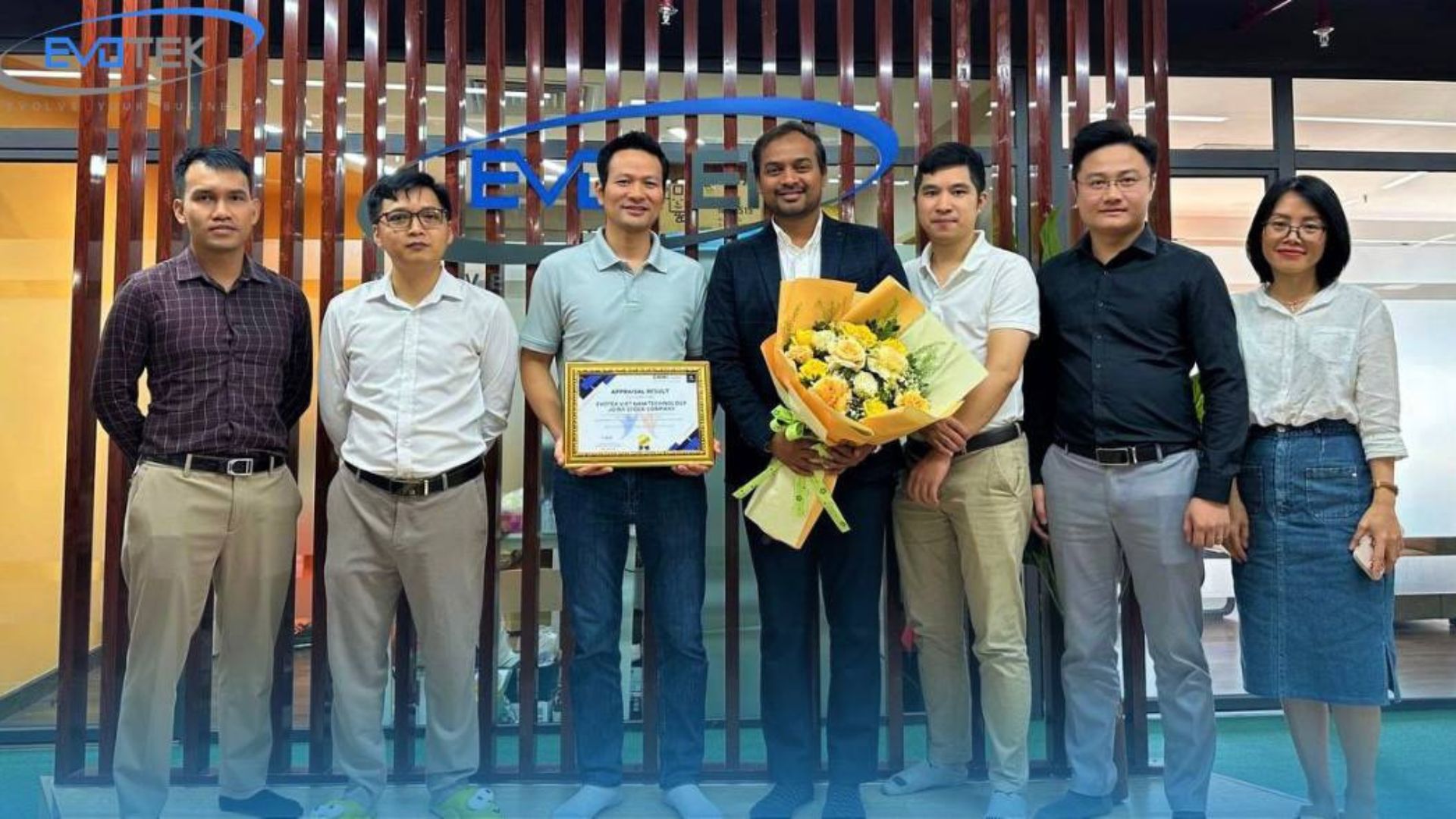
CMMI Level 3 Mang lại kết quả
- Hoàn thành dự án chất lượng, đúng tiến độ và ngân sách cho khách hàng
- Quản lý rủi ro tốt, giải quyết sự cố nhanh khi cần thiết
- Mang đến trải nghiệm khách hàng tốt về chất lượng và dịch vụ.
Với kinh nghiệm triển khai thành công hàng trăm dự án, đội ngũ kỹ sư giỏi và tuân thủ các tiêu chuẩn CMMI Level 3, Evotek xứng đáng là lựa chọn hàng đầu cho các dự án phát triển phần mềm doanh nghiệp.

 English
English 日本語
日本語 한국어
한국어 简体中文
简体中文